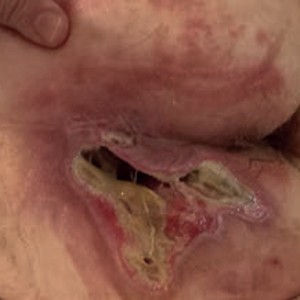Kennedy’s terminal ulcer and pressure injury: two different aspects of medical liability related to the same injury

Submitted: April 26, 2023
Accepted: June 9, 2023
Published: July 25, 2023
Accepted: June 9, 2023
Abstract Views: 728
PDF: 279
PDF (Italiano): 276
PDF (Italiano): 276
Publisher's note
All claims expressed in this article are solely those of the authors and do not necessarily represent those of their affiliated organizations, or those of the publisher, the editors and the reviewers. Any product that may be evaluated in this article or claim that may be made by its manufacturer is not guaranteed or endorsed by the publisher.
All claims expressed in this article are solely those of the authors and do not necessarily represent those of their affiliated organizations, or those of the publisher, the editors and the reviewers. Any product that may be evaluated in this article or claim that may be made by its manufacturer is not guaranteed or endorsed by the publisher.
Similar Articles
- Francesco Petrella, Franca Abbritti, Francesca Bachetti, Sonia Brizzi, Michele Bruscella, Piero Baà¹, Mario Cala, Ferdinando Campitiello, Giovanna Capace, Massimo Calveri, Marina Comandini, Giovanni Vito Corona, Teresa Cosentino, Amarilli Croce Casalena, Cinzia Datteri, Cristiana Di Campli, Raffaele Di Nardo, Enrica Di Spirito, Filomena Discenza Spensieri, Ciro Falasconi, Michele Angelo Farina, Caterina Favaro, Domitilla Foghetti, Andrea Frasca, Manuela Galleazzi, Pierluigi Gallo, Luca Gazzabin, Ivo Gerbelle, Manuela Germano, Francesco Giacinto, Serena Giannini, Giorgio Guarnera, Klarida Hoxha, Vincenzo Labbro, Vincenzo Lauletta, Deianira Luciani, Giuseppe Maierà , Giuseppe Maccarone, Cosimo Maglio, Paolo Mascioli, Vincenzo Mattaliano, Massimo Menculini, Piermauro Miraglia, Giovanni Battista Mosti, Marcello Napolitano, Giuseppe Nebbioso, Pamela Orazi, Fabio Pacifico, Maurizio Palombi, Piergiorgio Pastore, Marina Pierangeli, Stefano Priolo, Marco Romanelli, Donatella Rossolini, Elisa Ronzullo, Maria Teresa Scalise, Patrizia Scarpelli, Piero Secreto, Claudio Solinas, Marilena Tender, Stefano Trovò, I.S.U.S. PROJECT (ITALIAN SKIN ULCER STUDY) (1 January 2015-31 December 2016). Final data , Italian Journal of Wound Care: Vol. 1 No. 1 (2017)
- Giuseppe Nebbioso, C. Albanese, F. Bonat, A. Botta, Giovanni Vito Corona, Cira Costagliola, Corrado Maria Durante, Ciro Falasconi, D. Foglietti, Francesco Giacinto, Pasquale Longobardi, Klarida Hoxha, Cosimo Maglio, Vincenzo Mattaliano, Massimo Menculini, Giovanni Battista Mosti, Carmela Orefice, Sonia Remafedi, Donatella Rossolini, Felice Tafuro, Francesco Petrella, Quality of life study in Wound Care. Final report , Italian Journal of Wound Care: Vol. 1 No. 1 (2017)
- Ciro Falasconi, Vincenzo Amalfi, Patrizia Baroni, Giovanni Vito Corona, Corrado Maria Durante, Paola Fanin, Caterina Favaro, Massimo Fornaciari, Alessandro Farris, Manuela Galleazzi, Francesco Giacinto, Giorgio Guarnera, Vincenzo Lauletta, Mario Marazzi, Marco Masina, Vincenzo Mattaliano, Giovanni Battista Mosti, Giuseppe Nebbioso, Francesco Stanganello, Francesco Petrella, Survey on pain in patients with chronic skin lesions , Italian Journal of Wound Care: Vol. 1 No. 1 (2017)
- Ciro Falasconi, Vincenzo Amalfi, Patrizia Baroni, Giovanni Vito Corona, Corrado Maria Durante, Paola Fanin, Caterina Favaro, Massimo Fornaciari, Alessandro Farris, Manuela Galleazzi, Francesco Giacinto, Giorgio Guarnera, Vincenzo Lauletta, Mario Marazzi, Marco Masina, Vincenzo Mattaliano, Giovanni Battista Mosti, Giuseppe Nebbioso, Francesco Stanganello, Francesco Petrella, Survey on issues concerning eHealth and telemedicine in Wound Care , Italian Journal of Wound Care: Vol. 1 No. 1 (2017)
- Antonella Marcoccia, Carlo Salvucci, Tina D'Alesio, Tarquinia Nuzzo, Anoush Vartanian, Tiziana Guastafierri, Maria Grazia Modesti, Ultrasonic-assisted wound debridement for scleroderma digital ulcers , Italian Journal of Wound Care: Vol. 1 No. 1 (2017)
- Giovanni Mosti, Vincenzo Mattaliano, Pietro Picerni, Costantino Christou, Skin grafting in the treatment of hard-to-heal leg ulcers , Italian Journal of Wound Care: Vol. 2 No. 1 (2018)
- Lisa Turk, Tobias Thuile, Valentina De Marzi, Giovanni Antonacci, Mario Puviani, Klaus Eisendle, Hypericum perforatum and Azadirachta indica (Neem) oil in the management of chronic leg ulcers: An uncontrolled retrospective observational case review , Italian Journal of Wound Care: Vol. 5 No. 2 (2021)
- Fabio Mozzarelli, Sara Gaetti, Assessment of vascular ulcers of the lower limbs through the Wound Trend Scale: the experience of the Local Health Authority of Piacenza , Italian Journal of Wound Care: Vol. 2 No. 1 (2018)
- Alessandra Chiossi, Conversation Mapâ„¢: a tool for the education of the caregiver on the prevention of pressure ulcers , Italian Journal of Wound Care: Vol. 2 No. 3 (2018)
- Alberto Garavello, Margherita Lo Ponte, Stefania Gilardi, Paola Fiamma, Massimo Tozzi, Recurrent venous leg ulcers: clinical analysis of an experience , Italian Journal of Wound Care: Vol. 3 No. 2 (2019)
You may also start an advanced similarity search for this article.


 https://doi.org/10.4081/ijwc.2023.101
https://doi.org/10.4081/ijwc.2023.101




